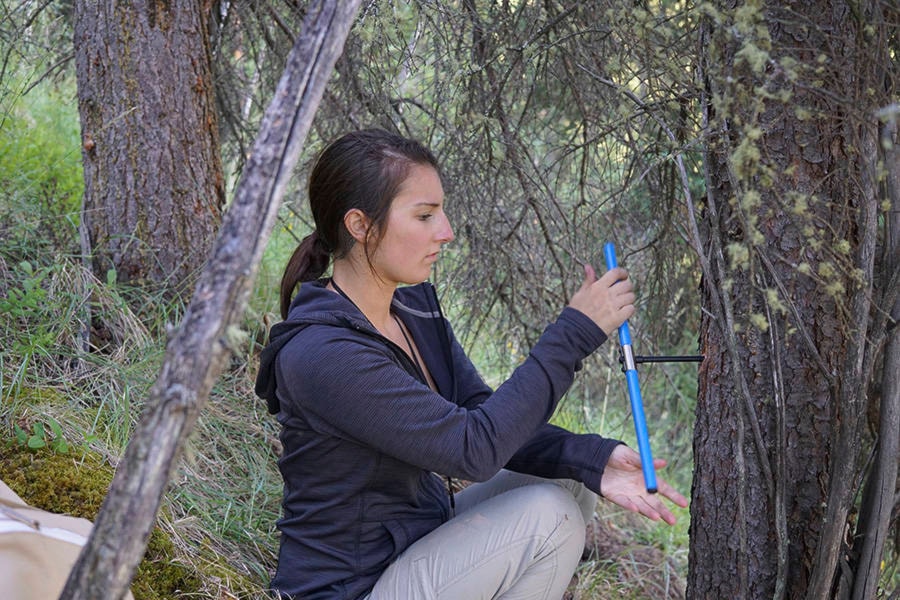A team of University of Toronto Mississauga researchers have published a paper looking at how Dawson-area trees hold a record of industrial mining history.
Paleoclimatologist Trevor Porter supervised the study in Bear Creek. His former master’s student Sydney Clackett was the lead author of the paper, which looks at historical mercury levels preserved in Dawson-area tree rings.
The article, titled “The tree-ring mercury record of Klondike gold mining at Bear Creek, central Yukon” will be published in an upcoming edition of the journal Environmental Pollution.
Mercury was once common in gold mining operations in the Klondike region during most of the 20th century, despite its toxic effects on humans when inhaled.
Mercury bonds to gold, helping to separate the valuable commodity from the surrounding sediment. Eventually, the two elements were separated by heat in order to leave gold behind. While most of the mercury could be captured and reused, vapours escaping into the atmosphere were absorbed by trees.
Porter said it’s important to note that mercury is no longer used in placer mining operations. He said the Bear Creek study, focused on a former mining site now under Parks Canada management, reflects historical levels of mercury locked in trees. He said the contamination that presents is not a major health threat to humans.
| The 'Gold Room' where mercury was used to extract fine gold from placer ore. Mercury was once common in gold mining operations in the Klondike region during most of the 20th century, despite its toxic effects on humans when inhaled. (Submitted) |
“Mercury is locked into the trees indefinitely until the trees die and break down and eventually mercury will work its way out of the system, but it’s going to be locked into the local environment for a very long time. The concentration in the trees is not incredibly high. It doesn’t pose a threat to health if you were to touch the tree, for example,” he said.
“I don’t think the data that we generated can tell us about how toxic the site is but it does tell us that mercury put into the environment during that period of time is locked into the biomass of the forest,” Porter said.
For this study, Porter and his colleagues collected core samples from white spruce in the Bear Creek area, where gold operations started to increase in the 1900s.
A tree bore, which is akin to a long hollow drill, removes a long pencil-like sample of wood that shows the pattern of the tree ring.
Back at a lab, the patterns of the tree rings can clearly be seen under a microscope. The sample and the tree rings can then be dissected, measured, analyzed and compared against a control sample from a different site.
As a paleoclimatologist, Porter often uses the tree rings to get a sense of how long a growing season was and what summer temperatures could have been. For this study the scientists analyzed the sample mercury levels in each year of the tree’s growth.
Porter has been working in the Yukon and Northwest Territories since 2005, where a short growing season preserves the record of how trees grow. Another co-author, Igor Lehnherr, a fellow geography professor who studies contaminants, grew up in the Whitehorse area.
Both researchers, along with Clackett, wanted to return to the North to combine their expertise in the study of mercury in a historical gold production area.
“Trees in the North have a very short growing season. The warmer it is during any given growing season gives the tree more opportunity to grow. So we can actually look at the rings the growth record in that tree, and follow it back in time,” he said.
By following the 151-year history of the tree through its rings, the researchers were able to match levels of mercury to the history of mining in the area.
“It was really remarkable to see how well the retrieved mercury records corresponded to what we could gather from the historical data,” Porter said.
| Looking down on the Bear Creek mining camp from the trees sampled for mercury.(Submitted |
For example, the concentration of mercury in the tree-ring increased most rapidly from 1923 to 1930, a period when several major mining operations were consolidated at Bear Creek. Mercury levels peaked during the 1930s, prior to the decline of gold production on the site.
After the closure of the Bear Creek camp in 1966, levels began to decline but return to background levels did not occur until the 1990s.
Porter said the study demonstrates the potential to use the method to analyze trees in the boreal forest that may provide a record of climate and pollution levels from the past into the present day.
“This study really validated this concept that tree rings are an important natural archive for mercury,” Porter said. “We’re starting to build a network of sites that we can use to better understand the natural mercury cycle and we can use that information to better understand how mercury may be changing in the future.”
Contact Haley Ritchie at haley.ritchie@yukon-news.com
